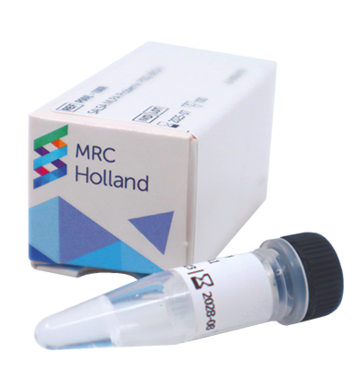Paragangliomas (PGLs) are neuroendocrine tumours that originate from neural crest-derived cells. They arise from sympathetic or parasympathetic paraganglia tissues and can be situated in the head and neck region, thorax, abdomen, and pelvis. Tumours that arise from the adrenal medulla are called pheochromocytomas (PCCs). Symptoms of PGL/PCC result either from mass effects (for example carotid body enlargement, visible in the neck) or catecholamine hypersecretion. PGLs are rare (incidence of ca. 2 in 1.000.000 individuals), and are most frequently found in individuals between the age of 30 and 50 years. For PCCs, the true incidence is unknown, as many affected individuals remain undiagnosed.
The hereditary PGL/PCC syndromes are inherited in an autosomal dominant manner. Pathogenic variants in the succinate dehydrogenase (SDH) genes, including SDHA, SDHB, SDHC, SDHD, and SDHAF2 (collectively referred to as SDHx) cause PGL/PCC and occur in up to 40% of cases. Probes for SDHA are not included in this P226 SDH probemix, but SALSA MLPA Probemix P429 SDHA-MAX-TMEM127 can be used to detect CNVs in the SDHA gene. SDHx genes are tumour suppressor genes and loss of heterozygosity is a second hit in tumours. SDHD and SDHAF2 demonstrate parent-of-origin effects and generally cause disease only when the pathogenic variant is inherited from the father (Hao et al. 2009, Hensen et al. 2004), with a penetrance of 90% or higher by the age of 70. Mutations in SDHA, SDHB and SDHC are inherited in an autosomal dominant manner with no parent-of-origin effect and show a low penetrance (Benn et al. 2006). Mutations in the SDHAF1 gene are a cause of the recessive disorder SDH defective infantile leukoencephalopathy (Ghezzi D et al. 2009), SDHAF1 loss-of-function might also cause PGL due to the function of SDHAF1 in the SDH complex. This association, however, has not yet been established.
It is estimated that 10-25% of hereditary PGL/PCC syndrome cases are caused by pathogenic variants in the SDHB gene, 2-8% in the SDHC gene, 8-9% in the SDHD gene. SDHAF2 mutations are very rare (<0.1%). The majority of mutations in the SDHx genes are point mutations and small deletions. It is estimated that 1.2-5.5% of patients with hereditary PGL/PCC have pathogenic CNVs in SDHB, SDHC, or SDHD, which include the known founder mutations: SDHB Dutch founder deletion in exon 3 and the SDHB Spanish founder deletion in exon 1 (Bayley et al. 2005, 2009, Buffet et al. 2012), all of which can be detected with this probemix.
More information is available at https://www.ncbi.nlm.nih.gov/books/NBK1548/.





